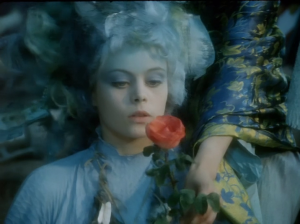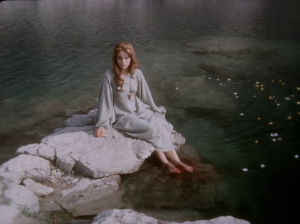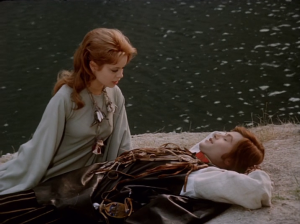I think it can be said that once Disney adapts a fairytale, the adaptation will eclipse the original story in the public’s consciousness. This rings especially true for their huge 1989 hit The Little Mermaid. Disney’s version is so influential that the name Ariel for many people under thirty no longer evokes the spirit in The Tempest but instead the dreamy red haired mermaid. Her iconic Glen Keane hair and green tail have influenced the depiction of mermaids, even in non-Disney merchandise, ever since.
The most disappointing result of this monopolization is that the Disney version, with its clear-cut villainy and happy ending, has in many ways diminished the awareness of the complexity found within the original story. In fact it has been posited that the story was written by Andersen as an expression of his pain for loving a young man which for many reasons was unrequited and could never be. It comes as a surprise to many people that the original tale has a considerably “bad end” for the Little Mermaid herself.
Luckily for those who want to become familiar with or are already fans of the original story there are a handful of both animated and film iterations, mostly from Russia in the 1950s to 70s. The Soviet studios of the time were very limited in what they could do; often the choice was between propaganda films or encouraged by the government adaptations of folk and fairytales and classic literature. Because of that choice, many of the most beautiful and true to source adaptations of fairy tales and novels like The Jungle Book and Andersen’s other masterpiece The Snow Queen come from animation studios like Soyuzmultfilm during that period.
Spinning out from that era is the 1976 live-action Czech film adaptation of “The Little Mermaid”, Malá morská víla. Directed by Karel Kachyna the film is a sensational but well-kept secret that should receive more attention not just as a faithful adaptation but also as a beautiful stand-alone film. Clocking in just under an hour and a half the film is sensitive, introspective and an utterly dreamlike piece that is unique amongst all iterations of the story in its balanced approach to saying faithful to the text and taking its own creative liberties (just like Disney did).

The first liberal and perhaps the most notable change is that the mermaids of Malá morská víla are presented as gossamer creatures, cloak-wearing water spirits, sans fish-tails (a point the Sea King in the movie openly mocks) of an unnatural pallor and elaborately twisted and sculptural hair decorated with found trinkets and seaweed. What’s more, these mermaids are not harmless. Their singing and the Sea King’s magic stones, much like the sirens and water spirits of lore, openly cause storms or hypnotize sailors and cause shipwrecks just for fun, after which they gleefully pillage for effects in a ceremonial fashion. There is a pronounced otherworldliness to their culture outside of the usual “I have fins and as such it is impossible to fraternize with humans” that has become standard in most modern tellings.



These choices makes all the difference. The world and culture of the mermaids, the Little Mermaid (played by the stunning Miroslava Safránková)’s year long curiosity about the human world after rescuing the Prince, and a subtextual storyline concerning her deceased mother, all take considerable emphasis over the actual romance of her and the Prince. In fact The Little Mermaid doesn’t transform and arrive on land until nearly sixty minutes into the film. Another element that is preserved from the original story is that the Sea Witch, while diabolical, is not vilified like the Disney version of Ursula. Unlike the original tale, the Sea Witch does not provide the Little Mermaid with a last minute solution to transform back into a mermaid should she fail to win the Prince’s heart. The dagger given to her to kill the Prince and his new wife and grant her the ability to return to the ocean is instead now attributed to the Sea King, which further removes the involvement of the Sea Witch from the story past her initial spell on the Little Mermaid. This choice is refreshing and adds additional complexity to the relationship between father and daughter.

The costuming and make-up work paired with the dreamy and painstakingly arranged sets, lighting, choreography and notable music all together truly creates a convincing murky underwater world of blue and grey and white for the mermaid’s kingdom without any actual water; this Little Mermaid is hardly ever actually wet in this film. The human world above in contrast is a palette mainly full of red, whites, apricot-salmon pinks, browns and muted turquoise-blue that is present all the way down to the lead’s complexions and hair colors. All above the water is bathed in almost stark sunlight which continues the film’s gorgeous cinematography choices in the human world as much as they did when under albeit in a more subtle manner.



This film, despite its own unique changes to Andersen’s original, is the most sensitive and successful live action adaptation of the story that I have seen barring the Russian animated version from 1968 Rusalochka which is also worth watching for it’s stunning stylized animation. It both expands the character of The Little Mermaid and stays at the core a faithful and beautifully melancholic interpretation that celebrates the beauty of its own sadness. Although it is hard to find with English subtitles, it is worth seeking out in HD either on DVD (or torrent at Eutorrents shhh) or watch it subbed here. You can also watch the entire film without any subs here. For fans of fairy tales, fantasy films, and seventies art films, this movie is a gem and is one of if not my favorite fairy-tale adaptation on film, period. A must watch.
Please if you haven’t seen this film and do watch it, let me know what you think of this adaptation!
Max Eber
Staff Writer/The Doctor
max@ihogeek.com
Twitter: @maxlikescomics















